Before this season, Pitcher List’s own Ryan Amore identified Dan Vogelbach as a deep sleeper for this season, but he wasn’t referring to sleep apnea or anything of the sort. Put simply, Amore thought that maybe the stars had finally aligned for Vogelbach. Then, albeit skeptically, I speculated in my 2019 bold predictions article that Vogelbach would hit 30 home runs this season. Vogelbach had a mixed spring training—he had 13 walks in 39 plate appearances, but only one of his seven hits was an extra-base hit. Regardless, there was reason for optimism.
As I’ve noted in the past, the Seattle Mariners have tried their darnedest to not play Vogelbach. The Mariners’ current regime, mind you, traded for him, and yet time after time they have passed on giving him any legitimate shot at starting in any capacity. He was very much unproven at the MLB level, and his defense is still quite subpar, but the Mariners have chosen to start a combination of Adam Lind, Dae-Ho Lee, Danny Valencia, and Ryon Healy over him in the past—all of whom have been mediocre at best.
After absolutely demolishing Triple-A pitching for the third year in a row, Vogelbach has finally gotten his opportunity. All it took was for Jerry Dipoto to trade half the roster, a Kyle Seager injury, and for someone to tell Scott Servais that Jay Bruce was their next option otherwise. Oh, and Vogelbach’s out of minor league options. Nevertheless, given the chance, Vogelbach has done nothing but rake.
Since 2018, this is how Vogelbach has stacked up, by percentile:
- xwOBA: 94th
- xwoBACON: 82nd
With the limited amount of data we have, Vogelbach has been one of the most elite hitters in the league, by xwOBA. On balls on contact, he hasn’t been as good, but still great.
In the same timeframe, this is how Vogelbach has performed in a few pertinent statistics:
- wRC+: 14th
- BB%: 6th
- Z-Swing%: 5th (lowest)
You can see that Vogelbach has been tearing the cover off of the ball, all while showing an incredible amount of patience. Surely, you can point to the small sample here, but it isn’t the smallest sample, either. We’re talking 282 plate appearances here, which is actually enough to start to feel comfortable with the reliability and stability of most of these numbers. We’re over 300 career plate appearances, and so we can have more confidence that these numbers are more likely to be indicative of Vogelbach’s skills, rather than random variation or luck.
Before we get too much further, I want to pump the brakes a little. A rolling graph of Vogelbach’s xwOBA, from 2018 to 2019:
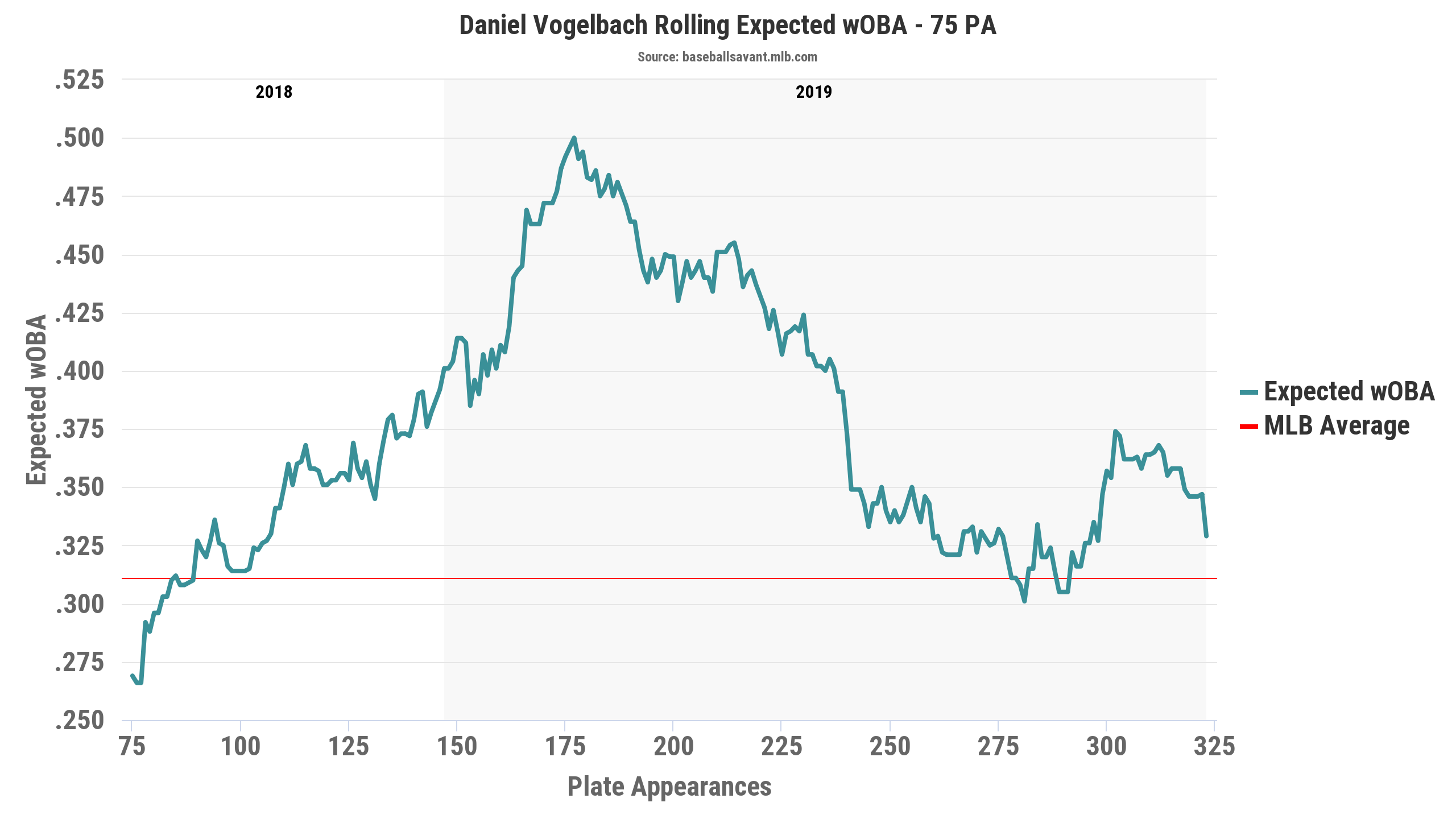
Since May 1st, Vogelbach has sported just a .329 xwOBA. Now, that’s certainly not bad—that’s better than that of Mitch Haniger, Paul Goldschmidt, and Khris Davis in May. On one hand, it makes it harder to argue that he’s breaking out. On the other hand, the fact that he’s barely dipped below the red line (i.e., MLB average) is encouraging, and that’s only a span of four weeks anyhow. To me, this shows that, while Vogelbach proponents shouldn’t start taking victory laps, he’s got a solid floor as a hitter. Due to his defensive limitations, that’s incredibly important for him.
Pitchers know he’s a fastball destroyer. He ranks 10th in the MLB in xwOBA (.480) against fastballs. That’s why just 51.7% of the pitches he has seen this year have been fastballs. That number may mean nothing to you, but the point is that pitchers have decreased their fastball usage against him since last year. To make it more palatable, Vogelbach is in just the seventh percentile of fastballs seen.
Here’s something Vogelbach did to a fastball from Emilio Pagan:
https://gfycat.com/BelovedKnobbyBlacknorwegianelkhound
It was absolutely crushed, and it got this reaction out of fellow baseball destroyer Nelson Cruz:
https://gfycat.com/BrilliantGrippingAustralianfreshwatercrocodile
To date, Vogelbach’s 12 home runs on fastballs are tied for fourth-most in the league. Here are the pitch locations on each of those home runs:
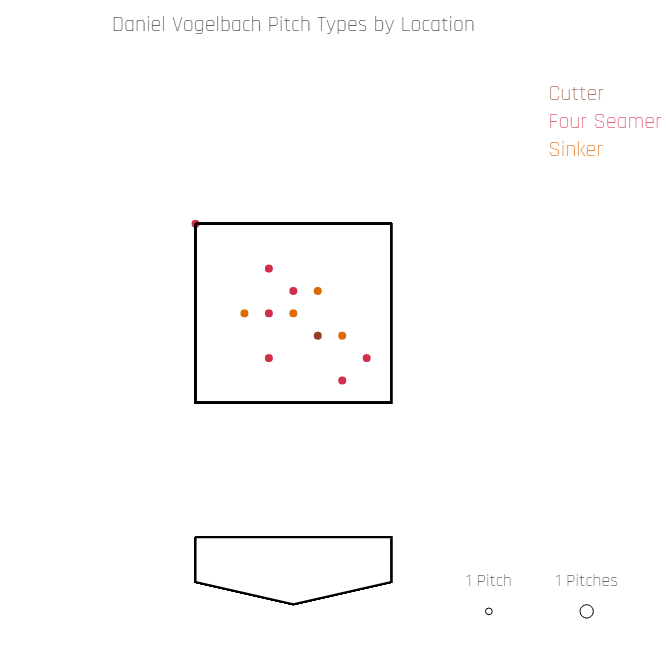
As you can see, all but one of these fastballs are out over the plate. Here are the pitch locations, this time for all of Vogelbach’s hits:
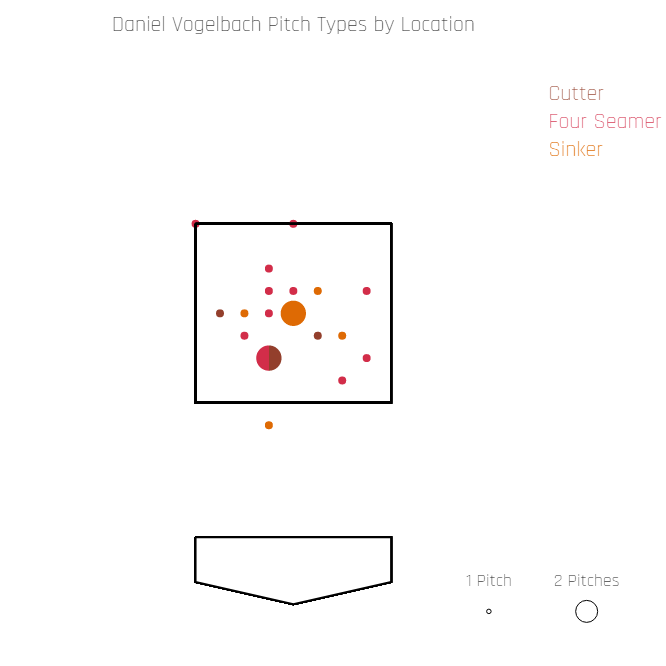
Same idea. Most of the pitches are out over the plate, with only one out of the zone.
Since Vogelbach has been so strong against fastballs, he has seen more breaking pitches this year—but not as much as you’d expect. By breaking pitches seen, Vogelbach ranks in the 62nd percentile (31.4%). At first glance, that’s surprising, given that his .216 xwOBA ranks in the 21st percentile against breaking pitches.
You may have noticed that he doesn’t see very many fastballs, and he sees just above the average in breaking pitches. So you, a savvy reader, obviously know that’s because he has seen 16.5% offspeed pitches, which puts him in the 85th percentile in that respect. Vogelbach would see much more breaking pitches if he didn’t have such elite plate discipline, but… he does, so he doesn’t see more breakers. Vogelbach has no qualms being stubborn and taking a walk, so his patience is allowing him to see more favorable pitches, and he’s capitalizing.
This is evidenced, again, by where his hits are coming from. This time, I’ve included breaking pitches, along with fastballs.
Vogelbach’s hits, by location:
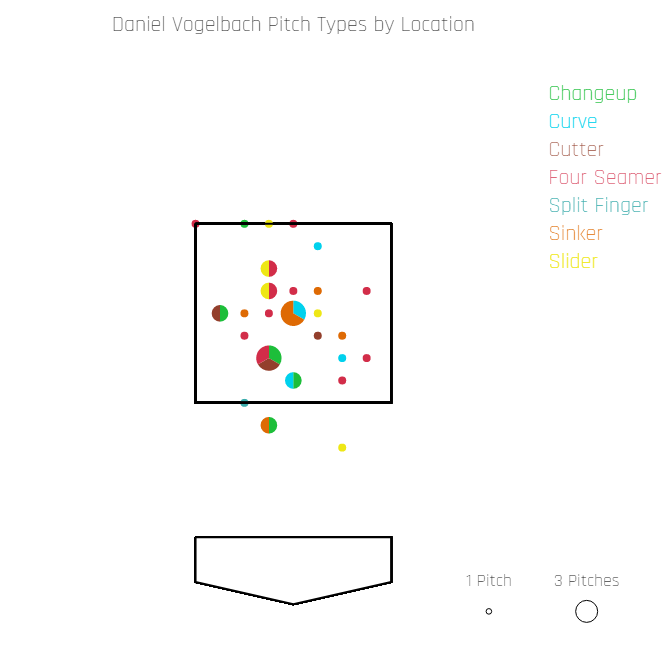
Now, Vogelbach isn’t good against breaking pitches—he’s bad, you could say. But every once in a while, a pitcher will let a breaker hang, and Vogelbach will take advantage. From two nights ago:
UPPER DECK VOGEY-BOMB pic.twitter.com/EhuKd7spvT
— Ryan Bloomfield (@RyanBHQ) May 28, 2019
This was an awful, awful pitch, and it wasn’t off of just anyone. This is Jose LeClerc, and Vogelbach showed off his strength here by taking it to the third deck at T-Mobile Park. It’s almost comical. Third-deck power is quite impressive, but even to me, it’s unclear exactly how rare it is. Allow Shannon Drayer to explain:
So we believe the only other 2 hitters to go third deck RF at T-Mobile are Mo Vaughn and Carlos Delgado. #Mariners
— Shannon Drayer (@shannondrayer) May 28, 2019
For a player with supposed 45-grade power (his current grade, per FanGraphs), it’s awfully impressive to be in the company of Mo Vaughn and Carlos Delgado—the pair combined for 801 career home runs. Vogelbach hasn’t been too shabby himself—he’s sporting 15 home runs on the year thus far, tied for seventh-most in the league. He’s not just a five o’clock hitter.
Vogelbach is an incredibly unique player. Because of this, it can be difficult to point to a player and speculate that’s what he is, or what he’s going to become. That doesn’t mean we can’t try!
First, overall output:
| BB% | K% | wRC+ | xwOBA | BABIP | |
| Dan Vogelbach | 15.0 | 24.8 | 127 | .380 | .247 |
| Player B | 11.7 | 23.7 | 124 | .372 | .327 |
There are a few key differences, but overall, the output is the same. The two go about it in slightly different ways—Vogelbach walks more and has a low BABIP due to a high home run rate—but the similarities are reasonable enough.
Next, batted balls:
| LD% | GB% | FB% | HR/FB | Pull% | Launch Angle | |
| Dan Vogelbach | 22.8 | 33.7 | 43.5 | 22.6 | 47.7 | 14.9 |
| Player B | 24.9 | 32.0 | 43.0 | 11.5 | 39.7 | 21.6 |
Again, across the board, pretty similar. However, in HR/FB, pull-percentage, and launch angle, we can see pretty clear discrepancies. However, I want to push back on a few of these, because Vogelbach has been morphing into a different type of hitter this year.
First, Vogelbach’s rolling launch angle:
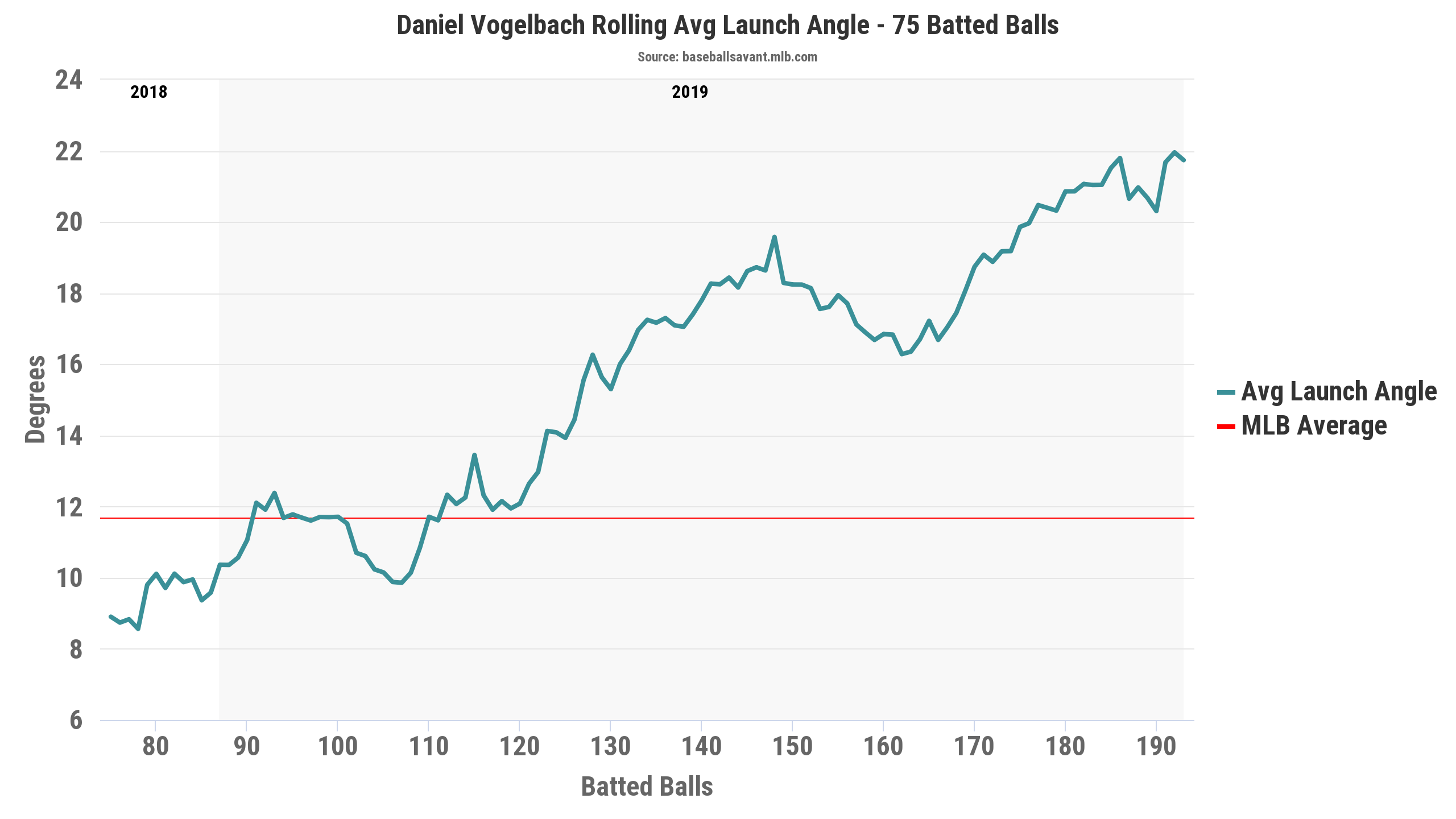
Average launch angle can be misleading, but we can see a clear, gradual upwards trend in launch angle for Vogelbach. He’s raised his average launch angle to reflect that of Player B.
Here’s another way to look at his average launch angle:
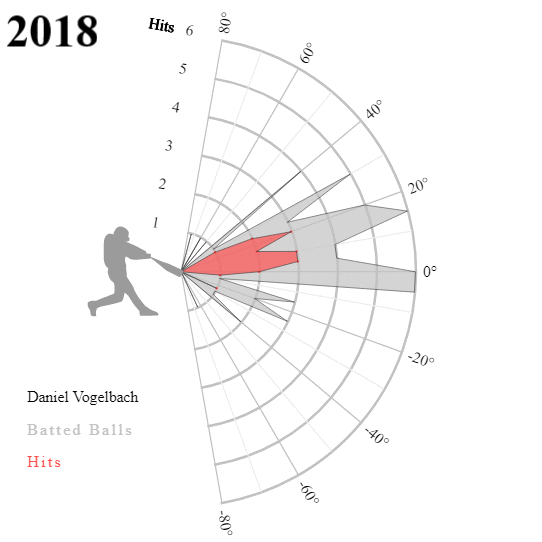
His average launch angle isn’t deceiving us—it’s truly changing. While his optimal zone of contact hasn’t changed too drastically, it has shifted up. He’s also changed where he’s creating outs. The majority of his outs previously came from -5 degrees to 20 degrees, whereas now they have (roughly) turned into 15- to 30-degree outs. The change itself is undeniable, and it’s purposeful, too. To put the cherry on top, Vogelbach’s 17.9% increase in fly-ball percentage is the most drastic change in the league from 2018 to 2019 (just ahead of Christian Yelich).
Second, the difference in pull-percentage between Vogelbach and Player B (47.7% and 39.7%) is becoming less drastic as well. Vogelbach has pulled the ball 44.9% in 2019, which closes the gap enough to call it close.
While Vogelbach distributes the ball well around the field, he has yet to flash all-fields power. Vogelbach’s 2019 spray chart:
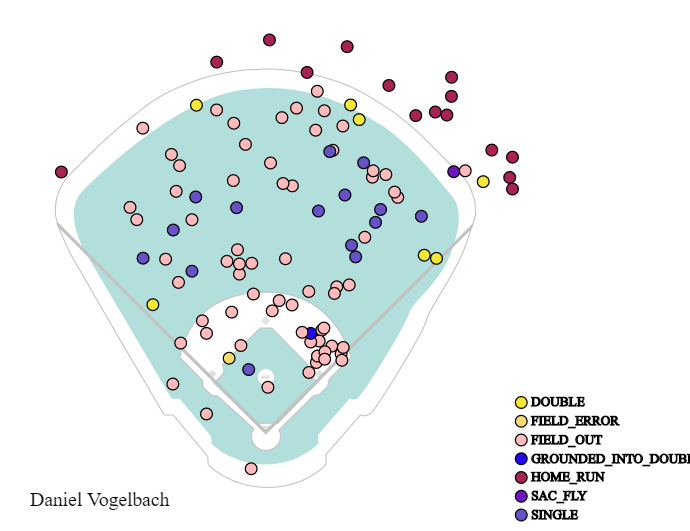
While he’s only taken one home run to the opposite field, he has gone dead center multiple times, and very few of his home runs have been cheap.
That leads us to plate discipline:
| Swing% | Contact% | Zone% | F-Strike% | SwStr% | |
| Dan Vogelbach | 36.0 | 77.1 | 41.7 | 56.1 | 8.2 |
| Player B | 48.8 | 76.3 | 41.4 | 59.2 | 11.5 |
The biggest difference between the two is that Vogelbach swings far less than Player B. The majority of this comes from swings in the zone—Vogelbach is the second-stingiest hitter in the league on pitches in the zone, and he swings at the fourth-least amount of pitches overall. He’s less prone to swinging-strikes than Player B, too.
By now, I’m sure you’re dying to know who Player B is. Hopefully, I’ve made it clear that this comparison isn’t perfect—they rarely are. In any case, Player B is first basemen Brandon Belt from 2016 to 2019, during his theoretical prime (ages 28 to 31).
If you ask me, Belt is one of the more underappreciated players in the league. He’s produced essentially three 4-WAR seasons, and he’s been relatively steady for the San Francisco Giants for nearly a decade now. If you ask me, Vogelbach has the opportunity to be Belt, but with power.
There are salient differences between Belt and Vogelbach. The most obvious is that Brandon Belt is tall and lanky, while Vogelbach is shorter and stouter—this has implications on the field. While Belt has accrued several plus seasons at first base (according to both UZR and DRS), Vogelbach is a liability on the field—so much so that he has seen just three starts at first base this year. On the base paths, Belt easily holds the edge on Vogelbach, but neither is exactly fleet of foot.
As it stands, Vogelbach has clubbed 15 home runs on the year. ZiPS estimates he’ll hit 16 more. Steamer thinks he’ll hit 13 more. THE BAT predicts 17. Depth Charts estimates 14. Regardless of your preferred projection system, Vogelbach could flirt with 30 home runs on the year. When I predicted he’d hit 30 home runs, never in my wildest dreams did I think he would be hitting at the pace that he is right now.
As I’ve said, he has the plate discipline to give himself a nice floor, but that’s not going to be enough to rationalize a major league team giving him at-bats. Because of his limitations as a baseball player, Vogelbach needs to hit, and hit well. So far, he’s been able to do that. If Vogelbach wants to be an everyday player, he’s going to need to tear the cover off of the ball. For now, it looks like that’s exactly what he’ll do. All he needed was an opportunity.
Featured Image by Justin Paradis (@freshmeatcomm on Twitter)

